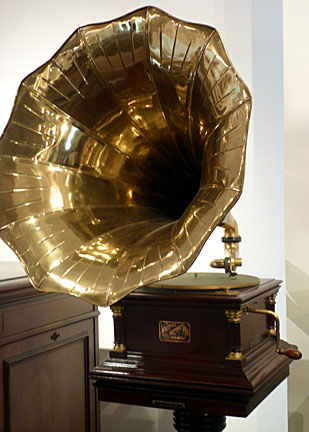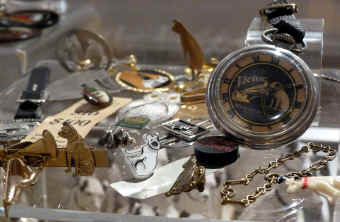|
His Master’s Voice
by Bob Brooke
One of the most recognizable promotional symbols in
U.S. commercial history began as part of a modest painting done by
English artist Francis Barraud of a mixed breed dog gazing into the
brass horn of a gramophone. This image was the basis for the famous
dog-and-gramophone trademark, one of the world's best-known, used by
several audio recording and associated company brands, including
Berliner Gramophone and its various successors, affiliates, and
successors, including Berliner's German subsidiary Deutsche Grammophon;
Berliner's American successor the Victor Talking Machine Company, later
known as RCA Victor and then RCA Records.
 The
dog’s name was Nipper. Born in 1884 in Bristol, England, Nipper was
probably part Russell Terrier, although some believe he was part Bull
Terrier. He was named Nipper because he would "nip" the backs
of visitors' legs. The
dog’s name was Nipper. Born in 1884 in Bristol, England, Nipper was
probably part Russell Terrier, although some believe he was part Bull
Terrier. He was named Nipper because he would "nip" the backs
of visitors' legs.
Nipper originally lived with his owner, Mark Henry
Barraud, in the Prince's Theatre where Barraud was a scenery designer.
When Barraud died in 1887, his brothers Philip and Francis took care of
the dog. Nipper died of natural causes in 1895 and was buried in a small
park surrounded by magnolia trees on Clarence Street in Kingston upon
Thames. Eventually, a branch of Lloyds Bank was built on the site. On
the wall of the bank, just inside the entrance, a brass plaque
commemorates the terrier that lies beneath the building.
 In
1898, three years after Nipper's death, Francis Barraud, his last owner
and brother of his first owner, painted a picture of Nipper listening
intently to a wind-up Edison-Bell cylinder phonograph. Barraud said that
it occurred to him to have his dog listening to the phonograph, with an
intelligent and rather puzzled expression, then call the painting
"His Master's Voice." He had a phonograph and often noticed
how puzzled his dog became trying to make out where the voice came from. In
1898, three years after Nipper's death, Francis Barraud, his last owner
and brother of his first owner, painted a picture of Nipper listening
intently to a wind-up Edison-Bell cylinder phonograph. Barraud said that
it occurred to him to have his dog listening to the phonograph, with an
intelligent and rather puzzled expression, then call the painting
"His Master's Voice." He had a phonograph and often noticed
how puzzled his dog became trying to make out where the voice came from.
Thinking the Edison-Bell Company, located in New
Jersey, might find it useful, he presented it to James E. Hough, who
rejected it saying, "Dogs don't listen to phonographs."
 On
May 31, 1899, Barraud went to the Maiden Lane offices of The Gramophone
Company with the intention of borrowing a brass horn to replace the
original black horn on the painting. Manager William Barry Owen
suggested that if the artist replaced the machine with a Berliner disc
gramophone, he would buy the painting. Barraud sold the slogan "His
Master's Voice," along with his painting, to The Gramophone Company
for £100 or $125 (equivalent to £10,628 or $13,254 today)—half for
the copyright and half for the painting itself. On
May 31, 1899, Barraud went to the Maiden Lane offices of The Gramophone
Company with the intention of borrowing a brass horn to replace the
original black horn on the painting. Manager William Barry Owen
suggested that if the artist replaced the machine with a Berliner disc
gramophone, he would buy the painting. Barraud sold the slogan "His
Master's Voice," along with his painting, to The Gramophone Company
for £100 or $125 (equivalent to £10,628 or $13,254 today)—half for
the copyright and half for the painting itself.
Emile Berliner, Owen's American partner, registered
the trademark in the United States on July 10, 1900, and Eldridge
Johnson acquired the rights when he merged interests with Berliner in
1901 to form The Victor Talking Machine Company.
The Company Behind the Trademark
 Meanwhile,
Eldridge Johnson’s Victor Talking Machine Company was producing its
earliest Victrolas, designated by "VTLA"—an abbreviation for
Victrola that appeared on the nameplate. Soon, the company marketed it
as "Victrola the Sixteenth" or VV-XVI. His company also
experimented with marketing a more deluxe model, with gold plated trim
on the cabinet, designated "Victrola the Twentieth" or VV-XX,
which sold for $300,. Victor produced only a few hundred of these models
before discontinuing due to the high cost. By 1908, Victor added
different finish choices, including oak, walnut, and even custom painted
versions to its cabinets. Meanwhile,
Eldridge Johnson’s Victor Talking Machine Company was producing its
earliest Victrolas, designated by "VTLA"—an abbreviation for
Victrola that appeared on the nameplate. Soon, the company marketed it
as "Victrola the Sixteenth" or VV-XVI. His company also
experimented with marketing a more deluxe model, with gold plated trim
on the cabinet, designated "Victrola the Twentieth" or VV-XX,
which sold for $300,. Victor produced only a few hundred of these models
before discontinuing due to the high cost. By 1908, Victor added
different finish choices, including oak, walnut, and even custom painted
versions to its cabinets.
By the middle of 1909, Johnson knew he had a huge
hit. He had already sold about 15,000 Victrolas, so he decided to
capitalize on his success by introducing a lower priced model. Later
that year, Victor introduced the tabletop Victrola XII, selling for
$125. This first attempt to make a low-price compact Victrola wasn’t
successful, however, since the horn opening was too small for adequate
volume in a large room. In 1910, the firm improved the sound quality of
its first tabletop model, replacing it with the Victrola X and Victrola
XI. But they were still too expensive for the average American
household.
 In
1911, Victor launched several new low-priced models, the VV-IV, VV-VI,
VV-VIII and VV-IX, with prices ranging from a remarkable $15.00 up to
$50.00. These machines were a huge success, and Victrola production rose
from several thousand per year in 1906, to approximately 250,000 per
year by 1913. In
1911, Victor launched several new low-priced models, the VV-IV, VV-VI,
VV-VIII and VV-IX, with prices ranging from a remarkable $15.00 up to
$50.00. These machines were a huge success, and Victrola production rose
from several thousand per year in 1906, to approximately 250,000 per
year by 1913.
By 1917, Victor was producing over a half million
Victrolas annually. The most popular one was the VV-XI floor model,
selling over 850,000 copies from 1910 to 1921. For the wealthy customer,
Victrolas were also available in a variety of custom designs, with hand
painted images, exotic wood, and Japanese lacquer finishes.
 In
November, 1925, Victor came out with the "Orthophonic"
Victrola, which featured the latest sound reproducing technology
offering far superior reproduction. The old style Victrolas sounded
anemic compared to these products. Dramatic improvements were made in
the design of the horns and the sound boxes. Victor achieved this
without the use of electronics, instead with sophisticated acoustic
designs. A rich tone now replaced the previous tinny Victrola sound. In
November, 1925, Victor came out with the "Orthophonic"
Victrola, which featured the latest sound reproducing technology
offering far superior reproduction. The old style Victrolas sounded
anemic compared to these products. Dramatic improvements were made in
the design of the horns and the sound boxes. Victor achieved this
without the use of electronics, instead with sophisticated acoustic
designs. A rich tone now replaced the previous tinny Victrola sound.
By the late 1920's, Eldridge Johnson, now a
millionaire, had grown tired of the business and decided to retire. In
1929, he sold The Victor Talking Machine Company and its logo to RCA,
which renamed the new company "RCA Victor."
 When
Francis Barraud finished the portrait of his dog listening to an Edison
Phonograph, he had no idea how powerful the image would prove to be.
Nipper, the terrier in the painting, would appear on millions of talking
machines and advertisements throughout the world. When
Francis Barraud finished the portrait of his dog listening to an Edison
Phonograph, he had no idea how powerful the image would prove to be.
Nipper, the terrier in the painting, would appear on millions of talking
machines and advertisements throughout the world.
For more information on the Victor Talking Machine
Company, please visit the Web page for the Johnson Victrola Museum in
Dover, Delaware at history.delaware.gov/museums.
PHOTO CAPTIONS: From top to bottom
This little bank is one of hundreds of Nipper items to promote the
Victor Talking Machine Company.
The edited painting produced by Barraud for The Gramophone Company of
London, England, using a model with a brass horn.
Large statues of Nipper graced the Victor showrooms and retail stores
selling Victor products.
Victor’s tabletop Victrola was a big seller because of its low
price.
The Victory Talking Machine Company, and later RCA, produced a wide
variety of promotional items featuring Nipper’s likeness.
This porcelain wall clock, featuring the RCA Nipper logo, was a
premium advertising item.
The Victor Talking Machine logo, featuring a likeness of Nipper, that
graced the front of Victor’s deluxe Victrolas.
|